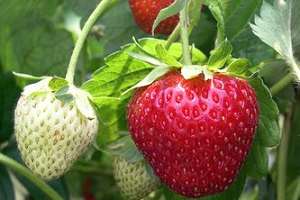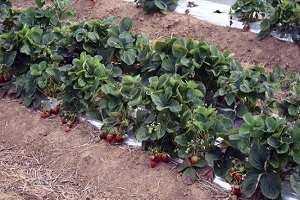Do you think older strawberry cultivars tasted better than the newer cultivars?
In the October issue of the Journal of the American Pomological Society, a team of horticulturists at Cornell University compared two popular strawberry cultivars from each decade from 1891 to 2003 (Harbut et al., 2016). I recognized some of the cultivars from my childhood in Massachusetts. My dad grew about 1/3 of an acre of strawberries in the late 1950s and 1960s and we sold fruit to our neighbors. It seemed that most of our cultivars came from only a few breeding programs. I remember cultivars like ‘Fairfax’, ‘Midland’, ‘Midway’, ‘Surecrop’, ‘Sunrise’, and ‘Suwannee’ from the USDA program in Beltsville; ‘Sparkle’, ’ Vesper’, and ‘Jerseybelle’ from Rutgers; and ‘Fulton’, ‘Catskill’, ‘Fletcher’, Frontenac’, and ‘Holiday’ from Cornell University. The only two ever-bearers we grew were ‘Ozark Beauty’ and ‘Geneva’ and the fruit were small, the plants were not very productive and the eating quality was only fair.

My dad’s favorite cultivar was ‘Sparkle’ because it was firm and tasted good. I liked ‘Vesper’ because the fruit were huge and tasted pretty good. When I was in high school I worked on a farm that had about 60 acres of strawberries. Most of the acreage was a strawberry nursery and any plants that weren’t sold were harvested for sales to local roadside stands. About 5 acres were saved for pick-your-own and I was the one who had to teach people how to pick strawberries. We grew more than 20 strawberry cultivars and after digging, cleaning, and bundling thousands of plants I could identify a lot of the cultivars just by looking at the dormant plants. It was amazing how different the crowns and root systems looked.
I started grad school on July 1, 1974 at the University of Vermont and my adviser, Dr. Bertie Boyce, had a fairly large strawberry cultivar trial. The strawberry season had already ended in Massachusetts, but mid-season cultivars were still being harvested in Vermont. Dr. Boyce took me to the research farm to show me around and some students were weighing strawberries from the cultivar trial. He decided to test me and handed me a box of fruit and asked if I could identify the cultivar. Fortunately, it was an easy one - ‘Catskill’. I told him that although ‘Catskill’ was very productive, I didn’t like the shape, it was too soft and the color was not very attractive - sort of pinkish red. He was surprised that I could identify the cultivar and after I was able to identify ‘Raritan’ he handed me one I had not seen. It was a new cultivar from Nova Scotia called ‘Bounty’. For the next three years, I was in charge of the strawberry cultivar trial, so I got to know strawberry cultivars pretty well.
After spending four years at Vermont, I went to Virginia Tech to work on apples for my PhD. There I met my future wife, who was working with a new type of strawberry called “Day Neutrals”. She had three cultivars; ‘Hecker’, ‘Tristar’ and ‘Brighton’, and they were different than June-bearers that initiate flower buds in the cool short days in late summer and fruit the following spring. They also differed from the ever-bearers I was familiar with that fruited in the spring and again in the fall. These day-neutral plants flowered and fruited almost continuously from June until fall frost killed the flowers. I remember that the fruit was only mediocre and during the hot summer days the fruit was soft. Some of the plants had very pubescent leaves and caused a rash on my arms during harvest.
Later, when I interviewed at UC Davis, I had the pleasure of spending about 40 minutes with Dr. Royce Bringhurst, the breeder of ‘Hecker’ and ‘Brighton’; ‘Tristar’ was developed at the University of Maryland. He found the day-neutral trait in wild plants growing in the Wasatch Mountains near Salt Lake City. In just a few generations he was able to drastically improve fruit size and flavor while maintaining the day-neutral characteristic. Today the California strawberry industry is built on day-neutral cultivars.
The story behind the development of the modern strawberry (Fragaria x ananassa) is really amazing. Before the discovery of the New World, European gardeners cultivated the wild wood strawberry (Fragaria vesca) and the musky strawberry (Fragaria moschata). These fruits tended to be small with mediocre quality. From about 1434 to 1857 European explorers collected plants from the Western hemisphere to send back to Europe. In the mid-1600s the “Virginia Strawberry” (Fragaria virginiana) was found in what is now Virginia. This species is native to much of eastern North America and had fruit 3 or 4 times larger and tasted better than European species.
The “Chilean Strawberry” (Fragaria chiloensis) also had superior size and flavor and was sent to Europe in 1712. F. chiloensis is native to western North America and South America. Unfortunately and unknown to the Europeans, F. chiloensis plants can be staminate (male), pistillate (female) and hermaphrodite (bisexual). Only pistillate plants were sent to France so they did not fruit because they required cross-pollination. Eventually French gardeners learned that F. chiloensis needed to be inter-planted with F. moschata or F. virginiana to produce fruit. The interspecific hybrid (F. virginiana x F. chiloensis) was produced in France in 1760 and was named F. ananassa. This new strawberry was called “Pineapple Strawberry” because it smelled and tasted like pineapple. So our modern strawberry was developed in Europe by crossing two species that were native to the Western Hemisphere. By 1771 New Englanders were importing F. ananassa plants from Europe and the first American hybrid, ‘Hudson’ was developed in the late 1830s in Rhode Island.
Now back to the paper from Cornell. Many people believe that older cultivars taste better than the new cultivars because breeding programs have been selecting for large firm fruit and disease resistance rather than flavor. I know from experience that newer cultivars of peaches are much better than older cultivars, so I would be surprised if older strawberry cultivars actually taste better than newer ones. Of the 20 cultivars they grew, both in the field and the greenhouse, they found no correlation between yield and decade of release. However, average fruit size increased linearly over time, and the number of fruit per plant declined over time.
Unfortunately they did not include ‘Howard 17’; released in 1909, it was an important commercial cultivar and was heavily used in breeding programs in the first half of the 20th century. Concentration of the red pigment, anthocyanin, varied quite a bit for different cultivars, but there was no trend over time. The dry weights of the crowns and roots increased with year of release, so newer cultivars tend to produce bigger plants. Fruit firmness increased nearly 50% from the early 1900s to 2000 and average soluble solids concentration (sugar) declined slightly over time from about 8.7% to 7.6%, but the relationship was not very strong and this small difference is probably not detectable by most people.
I think it is nearly impossible to evaluate soluble solids or flavor with data from a single season. Sugar levels are highest following several sunny days with moderate temperatures. So if one cultivar ripens a few days earlier than another, the flavor may be quite different due to the weather conditions preceding harvest. I think that cultivars need to be evaluated for at least 3 years to fairly compare flavor and sugar levels. They also found some differences in leaf physiology and some of these results might be useful for breeders. The genome of F. vesca has been sequenced, but it is a diploid (2 sets of 7 chromosomes). F. ananassa is much more complicated because it is an octoploid (8 sets of 7 chromosomes).

As geneticists continue to unravel the genome of the modern strawberry, the resulting information can be used by strawberry breeders to accelerate the development of new cultivars with high fruit quality while simultaneously improving fruit size, yield, and disease resistance.